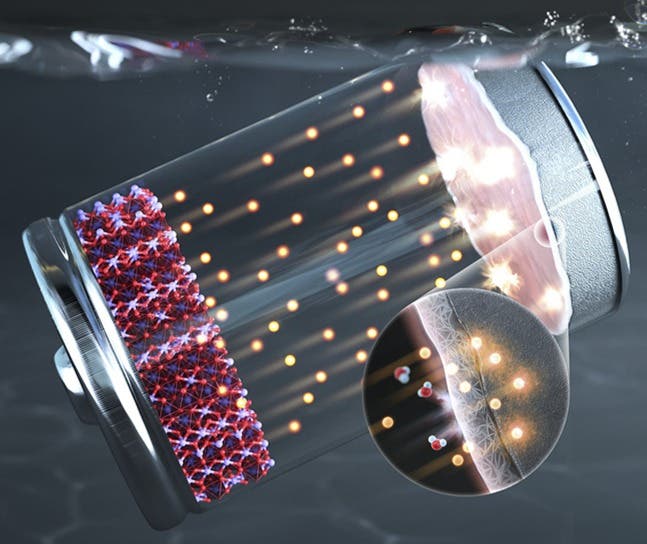Revolutionary ‘Water Battery’ transforms clean energy technology
Lightweight, high-capacity lithium-ion batteries are widely used in mobile phones, laptops, and other necessities in today’s world.

[Apr. 10, 2023: Jinyoung Huh, Pohang University of Science & Technology]
Schematic diagram of an aqueous zinc battery stabilized by a protective polymer layer (Credit: POSTECH)
Can we survive three minutes without air or three days without water? How about without batteries? Imagine not having a battery for three hours. Lightweight, high-capacity lithium-ion batteries are widely used in mobile phones, laptops, and other necessities in today’s world.
However, the organic electrolytes in conventional lithium-ion batteries are highly flammable, leading to fatal fires or explosions. As lithium-ion batteries are widely used in our lives, such accidents can cause direct damage to users, which has led to a demand for a safer battery system.
Professor Soojin Park and Gyujin Song (Post-doc fellow) in the Department of Chemistry and PhD candidate Sangyeop Lee of the Division of Advanced Materials Science at POSTECH together developed a stable aqueous zinc-ion battery that uses water as an electrolyte.
They employed a protective polymer layer to prevent electrode corrosion and increase the stability of the zinc anode, improving the electrochemical stability of the aqueous zinc-ion battery.
Related Stories
The organic-solvent-based electrolyte, which serves as a medium for ions to move inside the typical battery system, is inherently flammable, posing risk of explosion or fire. To address this issue, aqueous electrolyte batteries are being developed as promising replacements.
However, the inferior reversibility of the zinc anode in aqueous electrolytes, which are caused by zinc dendrites and surface side reactions, has prevented zinc-ion batteries from being used.
The POSTECH research team developed a zinc anode coated with a multifunctional protective layer by using a block copolymer. This new polymer layer is elastic and stretchable, enduring volume expansion during battery charging and discharging.
Schematic illustration of zinc anode during cycling(A) Bare zinc foil anode with dendritic growth that involves surface side reactions during cycling. (B) SEBS-MA coating layer induces smooth electrode surface with uniform Zn2+ ion flux and no side reactions. (Credit: POSTECH)
The polymer protective layer is found to induce homogenized ion distribution and suppress dendritic growth, contributing to a long-term zinc anode lifespan. The thin film layer also improves the electrode stability by suppressing unnecessary chemical / electrochemical reactions in the electrolyte on the electrode surface.
Furthermore, the researchers revealed the movement of zinc ions in the coating layer by using time-of-flight secondary ion mass spectrometry (TOF-SIMS) analysis.
Suppression of surface degradation by SEBS-MA layer (A and B) Top-view SEM images of bare Zn electrode before immersion (A) and after immersion (B) in 2 M ZnSO4 electrolyte for 5 days. Inset in (B) shows photo image of bare Zn after immersion. (Credit: POSTECH)
Imaging the zinc ion movements, which was not successful in previous studies, promises further research on the surface properties of battery anodes.
Recently published in Cell Reports Physical Science, this study was supported by Nano·Material Technology Development Program through the National Research Foundation of Korea.
Graphical Abstract: This study provides a facile fabrication process and accessible analysis methods to rationalize the development of high-performance zinc-ion batteries. (Credit: POSTECH)
Definitions:
1. Zinc dendrite: needle-shaped Zn deposits forming on the anode during cycling with detriment to the battery performance and stability
2. Block copolymer: macromolecules comprised of two or more different polymer chains joined together by covalent bonds
Note: Materials provided above by Pohang University of Science & Technology. Content may be edited for style and length.
Like these kind of feel good stories? Get the Brighter Side of News' newsletter.
Joseph Shavit
Head Science News Writer | Communicating Innovation & Discovery
Based in Los Angeles, Joseph Shavit is an accomplished science journalist, head science news writer and co-founder at The Brighter Side of News, where he translates cutting-edge discoveries into compelling stories for a broad audience. With a strong background spanning science, business, product management, media leadership, and entrepreneurship, Joseph brings a unique perspective to science communication. His expertise allows him to uncover the intersection of technological advancements and market potential, shedding light on how groundbreaking research evolves into transformative products and industries.



